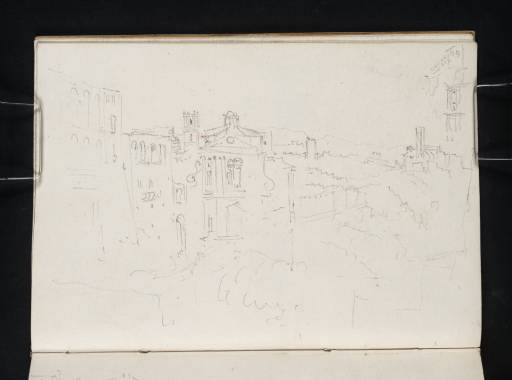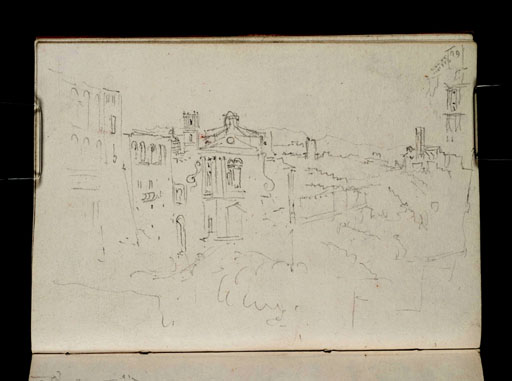Joseph Mallord William Turner The Church of San Giuseppe, Siena, and Surrounding Buildings 1828
Image 1 of 2
Joseph Mallord William Turner,
The Church of San Giuseppe, Siena, and Surrounding Buildings
1828
Folio 10 Verso:
The Church of San Giuseppe, Siena, and Surrounding Buildings 1828
D21607
Turner Bequest CCXXXIV 10a
Turner Bequest CCXXXIV 10a
Pencil on paper, 104 x 148 mm
Accepted by the nation as part of the Turner Bequest 1856
References
1909
A.J. Finberg, A Complete Inventory of the Drawings of the Turner Bequest, London 1909, vol.II, p.718, CCXXXIV 10a, as ‘Town’.
1984
Cecilia Powell, ‘Turner on Classic Ground: His Visits to Central and Southern Italy and Related Paintings and Drawings’, unpublished Ph.D thesis, Courtauld Institute of Art, University of London 1984, pp.303, 435, pl.185, as ‘S. Giuseppe, Siena, and its surroundings’.
This panoramic street view marks the first appearance in the sketchbook of Siena, a subject that features on over a dozen pages: see folios 10 verso, 11 recto, 13 recto–14 recto, and 15 recto–18 verso (D21607–D21608, D21613–D216014, D21616–D21623). Summarising Turner’s first visit to Siena in 1828, Cecilia Powell drew comparisons with Florence, a city more familiar to the artist after his first visit a decade earlier, and which he encountered for the second time in 1828. In Siena, Turner was ‘seeing everything for the first time’; despite the brevity of his stay, he explored much of the city ‘in the way he had explored Italian cities in 1819, making detailed and often complex sketches’.1
In addition to sketching the more familiar sites, such as the Campo and the Palazzo Pubblico, Turner also studied lesser-known churches such as San Giuseppe (the subject of the present sketch), as well as the Fontebranda fountain and the Basilica of San Domenico. For Powell, Turner’s Sienese stay proves that ‘his better sketches from the outward journey in 1828 are remarkably consistent with those of 1819 in their style and approach to composition.’2 As in 1819, Turner rarely depicted a single building on its own, favouring instead ‘architectural groups that formed pleasing ensembles’.3 Following a practice he adopted in Florence, he often walked to the periphery of the city ‘so as to sketch views that encompassed both countryside and architecture’.4
Executed with the sketchbook turned horizontally, this composition is dominated at the centre by the sixteenth-century Church of San Giuseppe, which lies to the south of the city.5 Turner’s viewpoint is facing north-east towards its main façade. His elevated vantage point was likely from the grounds of the Church of Sant’Agostino, overlooking the Via Sant’Agata. With characteristic economy, the architectural detailing is inconsistent and concentrated on the left half, whereas the right bay of the building is left largely blank. The windows and architectural features of the surrounding buildings are more loosely defined, becoming increasingly sparse towards the foreground. The distant tower to the far right is the campanile of the Basilica of San Clemente in Santa Maria dei Servi. In the top-right corner is an isolated detail of a building. For a view of the south-east façade of the Church of San Giuseppe, see folio 11 recto opposite (D21608).
Hannah Kaspar
November 2024
How to cite
Hannah Kaspar, ‘The Church of San Giuseppe, Siena, and Surrounding Buildings 1828’, catalogue entry, November 2024, in David Blayney Brown (ed.), J.M.W. Turner: Sketchbooks, Drawings and Watercolours, Tate Research Publication, February 2025, https://www


